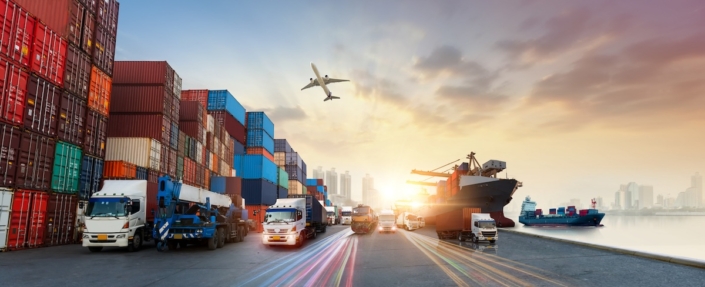Celebrated every year on April 29, National Supply Chain Day is a chance to recognize the efforts of people around the world who help keep goods flowing: warehouse managers, procurement specialists, delivery drivers, and many others. It’s also a great opportunity to reflect on all the advancements that have made today’s global supply chain possible.
To celebrate National Supply Chain Day this year, we decided to open the history books and explore how the supply chain has evolved throughout time. Ready to dive in?
Ancient trade routes
Today’s supply chains depend on sophisticated technology and transportation methods, but people have been creating and trading goods for thousands of years.
In ancient times, civilizations traded valuable materials using established trade routes and canals. These routes, which facilitated the exchange of goods over vast distances, laid the foundation for global commerce. Let’s look at just a few.
- Silk Road. The Silk Road allowed goods and ideas to be transported between China and Rome. These Eastern and Western civilizations traded valuables such as silk, wool, and precious metals. Rather than traveling the entire route themselves, merchants passed goods to middlemen, who carried them further before handing them off again.
- Incense Route. Over two thousand kilometers long, this network of trade routes was used to send frankincense and myrrh from the Arabian Peninsula to the Mediterranean. The profitable trade of these substances helped support the growth of prosperous agricultural settlements in the desert.
- The Grand Canal. Construction on this waterway system began in China in the 5th century BC; by the 13th century, the Grand Canal included over 2,000 km of waterways. These canals were used to transport raw materials for construction, as well as rice to feed the people. The Grand Canal is still used for shipping and irrigation and is the largest canal system in the world.
While these routes and waterways made it possible to transport goods, long-distance trade was incredibly arduous and time-consuming. For most people, the supply chain didn’t extend past the borders of their small communities. They grew crops or raised livestock, crafted goods by hand, and traded with their neighbors for what they needed.
All of that changed with the Industrial Revolution.
1760s: The Industrial Revolution
The Industrial Revolution began around 1760 in Great Britain, and the era marked a significant shift in the organization and scale of supply chains.
During this time, technology developed at a rapid rate. Coal-powered steam engines were used to power semi-automated factories. Textile production soared due to the creation of new machines for spinning thread and weaving cloth. Railroads made it faster and easier to transport goods across the land (ocean transportation still wasn’t very efficient).
For many years, the United States wasn’t as industrialized as Europe. They imported manufactured goods such as machinery and exported raw materials like cotton because Europe could manufacture things for cheaper. By 1870, the U.S. had begun to catch up, and it became an industrial leader by the early 1900s.
1890s–1930s: Transportation and warehousing improvements
During the late nineteenth and early twentieth centuries, innovations in transportation made supply chains more efficient. For example, the first semi-truck was invented by Alexander Winton in 1896, and as more roads were paved, trucking became a popular means of transportation.
Though they’re commonplace today, pallets transformed the world of logistics when they were first invented. Simple wooden boards have been used to pull objects since ancient Egyptian times, but modern pallets came into being along with forklift trucks.
In 1925, a man named Howard T. Hallowell patented the first pallet, calling it a “Lift Truck Platform.” In 1939, George Raymond Sr. and Bill House were granted a patent for pallets as well. Pallets greatly improved warehouse efficiency; in addition to helping with the fast transportation of goods, they made it possible to stack goods, making better use of vertical space.
Today, experts estimate that billions of pallets circulate through the global supply chain.
1950s–1970s: The rise of intermodal transportation
Over 80% of the volume of international trade is carried by sea, and it’s even higher for many countries. And it’s all possible because of the shipping container.
Like the pallet, the shipping container is largely taken for granted. But before its invention, ocean transportation was slow and inefficient. Goods had to be loaded and unloaded individually, which took a long time and increased the risk of theft or damage.
In 1937, truck driver Malcolm McLean had an idea: create standardized containers that could fit on ships, trains, and trucks. Twenty years later, the first shipping container made a voyage from Newark to Houston. These intermodal containers, which were standardized by the 1960s, made freight shipping more cost-effective and fast. Instead of manually loading and reloading ships at every port, workers could simply transfer shipping containers from one mode of transportation to another. The Vietnam War helped drive widespread adoption of shipping containers because there was a pressing need to send supplies overseas.
1960s–present: Globalization and technological advances
With increased manufacturing in Asia, the economy became more globalized. At the same time, new technologies accelerated supply chain development.
Globalization
The increasing interconnectedness of economies on a global scale has transformed supply chains, leading to outsourced production, the rise of multinational corporations, and complex networks of suppliers and subcontractors.
The United States really began seeing the effects of increased globalization in the 1980s and 90s, when it began importing products from Asian countries such as China, Japan, and Korea. These countries, particularly China, had competitive advantages in terms of low labor costs and large-scale manufacturing capabilities. In 1985, the U.S. imported $3,861.7 million worth of goods from China; in 2023, it imported $427,229.2 million worth of goods.
As global supply chains became less localized and more complex, logistics professionals developed more organized ways of approaching tasks. In 1982, the term supply chain management was coined by Keith Oliver in an interview with the Financial Times. He defined the new term as “the process of planning, implementing, and controlling the operations of the supply chain, with the purpose to satisfy customer requirements as efficiently as possible.”
Information technology
Around the 1960s, computers paved the way for new supply chain technologies. Throughout the next decades, this tech became more powerful and integrated, giving logistics professionals new tools to forecast and plan. Today, advances in computing, telecommunications, and data analytics have enabled real-time tracking, demand forecasting, inventory optimization, and process automation.
2020: The COVID-19 pandemic
In 2020, the world faced an unexpected challenge: the COVID-19 pandemic. The pandemic highlighted vulnerabilities in supply chains and disrupted production, distribution, and logistics worldwide.
A 2021 government report describes why COVID-19 had such a huge impact on supply chains: “When the pandemic hit, businesses were stuck with billions of dollars in unsold goods, causing inventory-to-sales ratios to surge briefly before businesses liquidated these inventories. But, as the economy recovered and demand increased, businesses have not yet been able to bring inventories fully back to pre-pandemic levels, causing inventory-to-sales ratios to fall.”
With store shelves empty and online inventory selling out fast, companies began to rethink their supply chain strategies and invest in greater flexibility and redundancy.
2024 and onward: An ever-evolving supply chain
As businesses finally begin to overcome the effects of the COVID-19 pandemic, they’ve strengthened their supply chains in many ways. But the future has even more innovations and improvements in store.
What can you expect moving forward? Let’s look at just a few supply chain trends for 2024 and beyond. (Many of these ideas are from our January podcast episode with Chris Caplice.)
- Industry 4.0. This concept, also known as the Fourth Industrial Revolution, centers around the idea that the supply chain is experiencing a fourth industrial revolution. Whereas the three previous revolutions were powered by steam, electricity, and early automation, this one is powered by technology like advanced robotics and automation, AI, data analytics, and more.
- Humans and technology working together. What place do humans have in Industry 4.0? Chris is confident we’ll find the right balance of human labor and automation. “Humans are not leaving. We’re not going anywhere. The question is, where do we fit in the automation process? These new tools—whether it’s AI, machine learning, neural nets, large language models—[they make] it so [we] can focus on things that are more complex. Let the robots handle the simple stuff.”
- Supplier diversification. Recent geopolitical conflicts have caused organizations to reevaluate their supplier lineups. Chris notes, “There’s been a lot of [talk about moving] away from China for some of your suppliers, and that’s easier said than done. The U.S. and other Western countries have woken up to the idea that they need to be a little more self-sufficient. I don’t think global trade is going away … but I think we’re being more strategic there.”
- Sustainability and ethical sourcing. Seventy-four percent of consumers care about the environmental impact of the products they buy. This growing awareness of environmental and social issues has led businesses to shift towards sustainable and ethical practices in supply chains.
Happy National Supply Chain Day from EasyPost!
There you have it: a brief history of the supply chain, from ancient trade routes to cutting-edge technology. Hopefully you gained a deeper appreciation for seemingly simple supply chain elements (we’re looking at you, pallets), and learned something new about the intricate web that keeps goods moving across the globe.
Happy National Supply Chain Day!
P.S. Looking for a way to optimize the last-mile delivery stage of your supply chain? Simplify your shipping and save on carrier rates with EasyPost’s suite of Shipping APIs. Start shipping for free.




